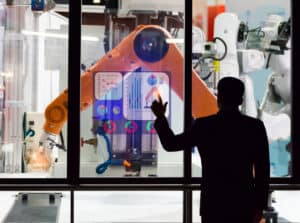
With more IoT devices being installed and deployed in manufacturing plants and on production lines all the time, new applications for IoT data (beyond the more well-known use cases) are starting to emerge.
Spending on the Internet of Things (IoT) in manufacturing is booming and will grow at a double digital compound annual growth rate (CAGR) for years to come. As IoT devices become ubiquitous throughout manufacturing processes and plants, manufacturers are doubling down on traditional use cases for IoT and finding new application areas where the devices can be of additional help.
Two recent market research reports put the growth in IoT adoption into perspective. Mordor Intelligence pegs IoT manufacturing spending at $390 million this year and predicts it will grow to $1.22 trillion in 2029, representing a 25.33% CAGR. Another market research study by SkyQuest finds a comparably large CAGR of 23.30% for manufacturing IoT spending through 2031, when the market will be $2.114 trillion.
Why is that growth so important? The data from the large installed base of IoT devices (and that data’s analysis) gives manufacturers many ways to improve operations based on data-driven insights. Many use cases for such insights that manufacturers have used for years are enhanced and deliver greater benefits with more IoT data to work with.
For example, one of these most common use cases is using IoT data to optimize production processes. IoT devices allow manufacturers to monitor production status in real time. The collected data from production line equipment can be analyzed to help identify production-related problems and potentially spot areas for improvement. As more IoT devices are added to a product line or plant, there is simply much more data to base decisions on.
See also: Report Outlines Growth, Obstacles of Predictive Maintenance Market
Reducing production problems with IoT
The biggest impact of IoT in the industry is in converting manufacturers from reactive to proactive when dealing with problems that shut down or degrade production operations.
It might be something as simple as noticing that the motor in a piece of critical assembly line equipment is running hotter than normal. That might mean the motor is running faster than it should for a specific production process. Unaddressed, that might lead to poor output quality.
That same piece of information about an item operating outside its normal range might also mean the equipment (a motor in this case) is about to fail. When it does stop working, it could shut down a production process, a production line, or an entire plant.
Without IoT data on the equipment’s health, manufacturers might not even know what caused an outage. Once they figure out the source of the problem, workers would need to physically go to the machine and replace the defective part to restore the equipment to working order.
If people with the right skills to work on that piece of equipment are not onsite, the outage will continue while they travel to the plant. And once there, they might find that the needed part is not in stock. After ordering it, it could take days, weeks, or months for the part to be delivered…extending the outage even longer.
These issues are why IoT and IoT data are so widely embraced in manufacturing for their ability to provide predictive insights into operations.
The various temperature, vibration, voltage, speed, and other measurements from IoT devices allow manufacturers to monitor equipment health in real time. Anomalies in any of those measurements over time can provide an early warning of trouble in the making.
Obviously, many manufacturers have taken this type of analysis of IoT data further, using the insights to support predictive maintenance efforts. Such efforts seek to identify problems in the making and fix them before the equipment fails. That would avoid downtime.
Others have enhanced their predictive maintenance efforts by tying the insights about potential equipment problems into their inventory management and parts ordering systems. In that way, when a potential issue is identified (e.g., a motor running hot), that would trigger a number of actions. A check would be made to see if a replacement part is in stock. If not, the part would be ordered. Then, maintenance would be scheduled to replace the failing part.
New IoT applications emerge
With more IoT devices being installed and deployed in plants and on production lines all the time, new applications of IoT data beyond the more well-known use cases are starting to arise.
One growing use case is the merging of IoT data with virtual reality (VR) and augmented reality (AR) technologies.
For example, a manufacturer might combine real-time IoT data with a VR replica of a piece of equipment to train an operator or maintenance person on that equipment. In that way, the person gets familiar with the equipment and gains experience in how to operate or repair it. When they get to the equipment, there is no learning curve; they are ready to work.
With AR, data can be projected on a tablet or goggles to assist a worker. For example, over-laid AR operational data could guide a maintenance worker trying to adjust controls on sensitive equipment.
In both application areas, real-time IoT data visualization can significantly improve that worker’s efficiency and effectiveness.
A word of caution about the expanded use of IoT
As more IoT devices are deployed in manufacturing environments and they become more integrated into operations, security must be addressed.
Like any type of connected device, IoT devices are susceptible to growing cybersecurity threats. That alone is cause for concern. But the security issue is even more serious today due to the fact that many manufacturers are now merging their operational technology (OT) systems that run the plan floor with their IT systems that run the business.
As such, manufacturers must take measures to secure their IoT devices and safeguard their data. Additionally, they must keep the software running on those devices patched and up to date.
Doing so will allow manufacturers to reap the benefits of IoT technology and develop new use cases based on the availability of IoT data and analytically derived insights.







